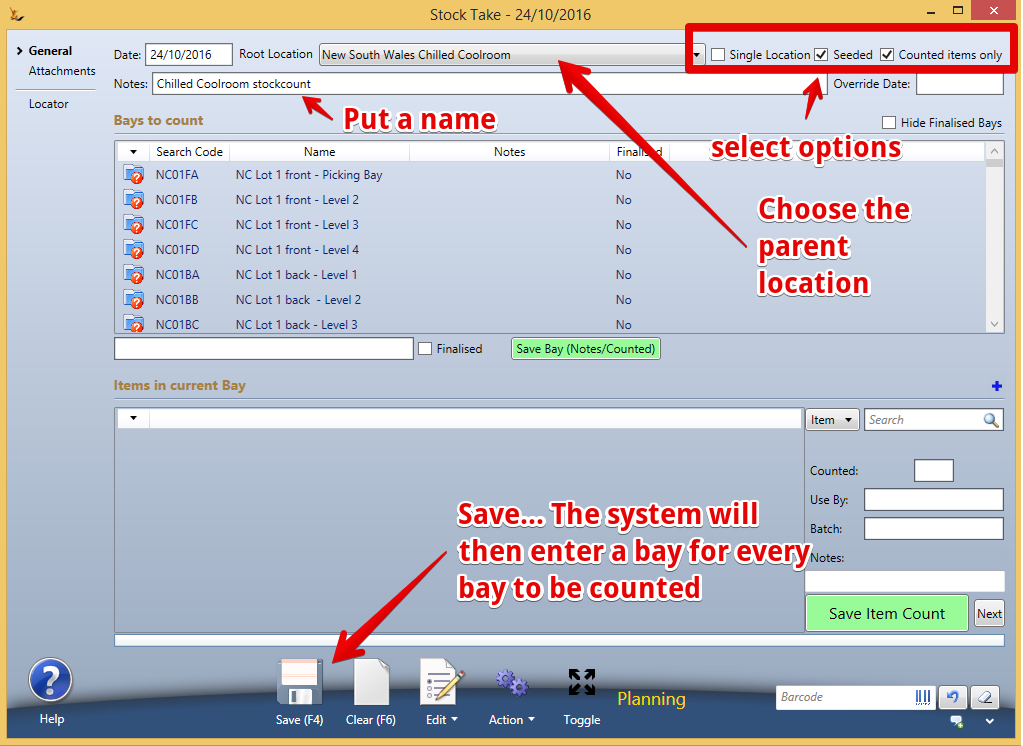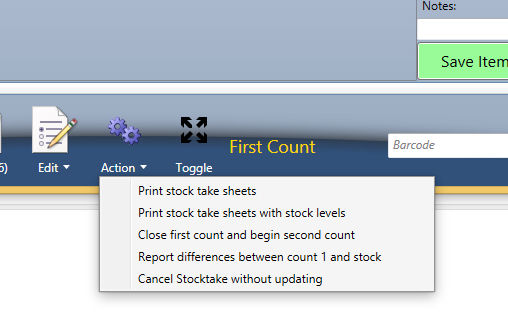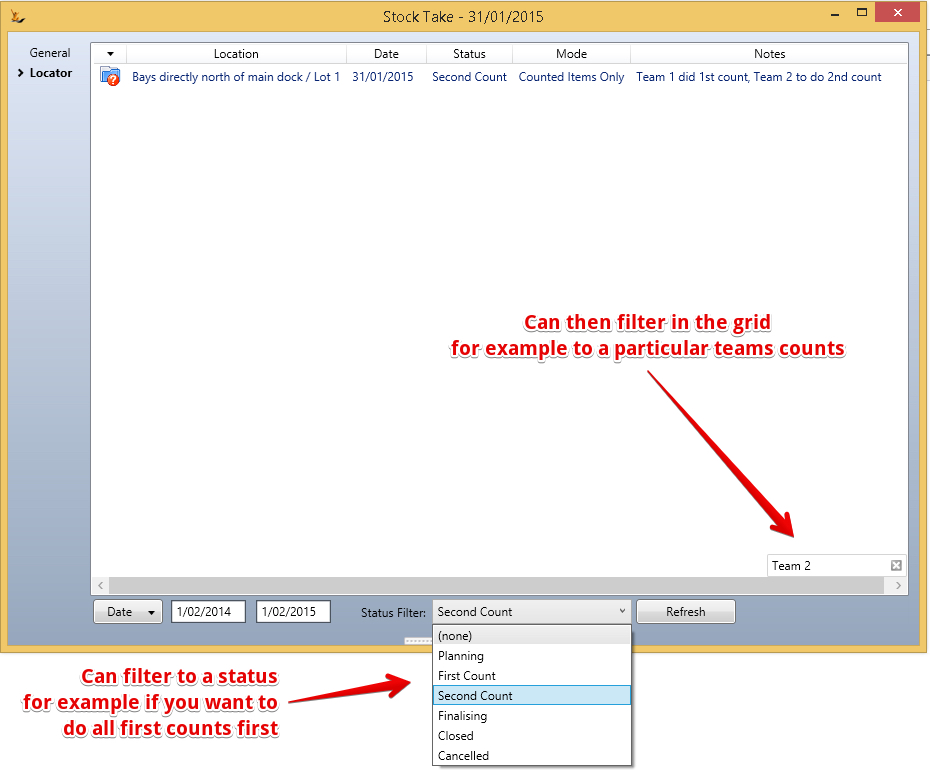...
Regular stock takes ensure the inventory levels in your account are accurate.
Stock Locations explained that hold stock are "Lot / Pallet Bay"
Options:
- require that Counted items only
- Not selected all items
- must be counted
- Selected -
- only the
- items
- enable updates only on items you do count
Stocktakes are designed as a blind two count process to cross check counts.
...
- with a count in count 2 will be updated
- Single Location
- Selected = single location only
- Not Selected = Location + child locations
- Seeded
- Selected = will seed the stockcount with items you expect to find but no counts
- Not Selected = no items seeded - must count all items. Any items not counted will be removed from stock
Shortcuts
Can Copy Count 1 to Count 2 and then finalise from Count 2. This effectively means you only do a single count
For all stocktakes you can print out the current stock levels of all stock the system thinks is in the counting locations.
When using Seeded Stocktake - the counting sheets are the same layout as the current stock level sheet - so it is easy to look for discrepancies between the system levels and the counted levels.
Process
A First Count, A Second Count, Finalising and then create Journals based on the second count vs current system stock levels
You will need Secure Features to perform stocktakes
Set stock locations that store stock to "Lot"
| Note |
|---|
When setting up a new company that has existing stock - you can count the stock and not write journals - instead using a single journal line for the stock value. This feature can also be used to count stock that you do not need to do journals for adjustments - for example stock held on consignment |
Updating Stock Levels while conducting normal business
If the stock in a location is getting to a low level then the system may prompt the user to confirm if the number the system thinks still remains is correct.
Before you start
| Note | ||
|---|---|---|
| ||
Stock is not normally stored in a floor area . So if - a floor area is where stock is checked before being stored, or assembled to go out on an order. If any selected level to do a stock count has stock in a floor area then the stocktake cannot be started until any stock in an included floor location has been put away. The move order form will open. |
...
Seeded stocktake (system provides a list of what you should find in the location)
The system provides a list of the products that you should find in each location including batch numbers and expiry dates - but not stock counts.
Simple Seeded stocktakes are faster - however users tend to look for what they see on the screen rather than check all the stock in a location.
Simple Seeded stocktake is recommended for quick stock checks.
| Note |
|---|
All Stock Articles in a location will have to have a count = even if it is zero |
Regular Stocktake (blind counting)
Regular stocktake
- Two blind counts of a stock area
- Comparison report shows differences - the second count can then be checked
- Second count is then used as final stock
Notes area can be used as part of the process. For example if you have 10 teams and have allocated team numbers to counts - enter this in the notes so can filter the locator grid by team. - see SecondCount(blindcount)
| Note |
|---|
Until you get experienced - count a single warehouse bay at a time.
|
Select the area that will be counted in one count
- Counted Items Only - Only the items counted will be updated - all other items in the locations will remain at current stock levels
- Full - only stock counted will remain in the bay after counting
- Notes might be useful later
Start first count
To start the first count
Counting
| Note |
|---|
Multiple users may be entering data for a count at the same time |
...
Seeded Stocktake combined with Counted Items only allows only the items counted to be included - so it is easy to count only a brand or location.
Creating a stock count
Action - Start First Count
Once first count is started there are a number of print options. A manager is likely to want to print stocktake sheets with stock levels to compare with actuals.
Counting sheet printouts
Seeded Stocktake - printout has bays, stock article expected - but no count
Not Seeded Stocktake - printout has bays only
Counting
Enter stock articles, counts, expiry dates and save.
Delete any line using rightclick in the grid
Multiple users can be entering counts at the same time.
| Note |
|---|
Barcodes for locations and stock articles can be used to rapidly enter the information |
Close first count and start second count
When ready to finish first count
Can compare with system stock levels before closing the first count
Or can simply close first count and begin second count.
Second Count (blind count)
Same process as the first count
| Note |
|---|
If the stocktake does not need a second count - copy the first count to a second count |
Finding locations that need a second count
Count the stock in the same way as the first count.
Comparing 1st and 2nd Counts
Close Second Count and Report Differences
Any differences will show in a report - allowing a recount of any discrepancies
Simply update the counts until you are convinced the second count is correct.
Report differences again
| Note |
|---|
After any changes to counts you will need to report differences again to proceed |
Comparing Second Count to System Stock Levels
Again a list will show - recheck and update any counts you wantmove to second count - a different group may count.
Can update the notes on the overall stocktake or at the bay levell with who counted where
Compare 1st count and second count
When second count is complete - do a comparison to check any items that require to be check counted
Finalise
Finalisation enables a review and any counts required can be updated.
Create Journals and Close
Any required journals will be written
| Note |
|---|
The description on the Journals created will include the Notes on the Stocktake. Journals created will also be placed into a single batch for the stocktake so they are easily found and reviewed. |
Finding locations that need a second count
Perishable Items Special Note
| Note | ||
|---|---|---|
| ||
When counting perishable items - a useby date is captured. If the product is a purchased product then for traceability and recall reasons - the expiry date must be one that was received on a Purchase order recently enough not to have expired. The system looks to find any purchase orders that were received into the system and the expiry dates of the items received. The system will link the stock to the most recently receipted with that useby. If the system cannot find the useby on any stock receipt - it will not allow the stock to be created by the stocktake. You will see the stock with errors in the comparison with stock list |
...
Journal Stock Differences
...














